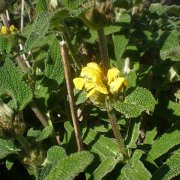Care of the shrub Phlomis viscosa or Viscid Jerusalem Sage |
|
The genus Phlomis, family Lamiaceae, comprises 100 species of shrubs and herbaceous plants native to Asia and the Mediterranean region. Some species are: Phlomis viscosa, Phlomis purpurea, Phlomis maroccana, Phlomis lycia, Phlomis lanata, Phlomis fruticosa, Phlomis cypria, Phlomis chrysophylla, Phlomis italica, Phlomis russeliana, Phlomis samia, Phlomis lychnitis. Common name: Viscid Jerusalem Sage. This species is native to the Middle East. They are highly branched shrubs with a compact bearing and sticky touch that reach 1 meter (3.28 feet) in height. The leaves are dark green, lanceolate and have a rough and velvety texture. The intense yellow flowers appear in groups surrounding the stem. They bloom in spring and sometimes also in fall. Viscid Jerusalem Sage is used to create hedges, shrub groups, borders and in rockeries. Phlomis viscosa needs full sun exposure. It does not resist the salinity of the sea but it does resist frosts down to -10 ºC (14 ºF). Viscid Jerusalem Sage grows in very limestone and stony soils, but it appreciates a well-drained substrate that contains a little organic matter. Phlomis viscosa has high resistance to drought; water sporadically during the summer. A light compost-based fertilizer will suffice in the second half of winter. Prune in late winter to keep it compact. Phlomis viscosa is a resistant plant to the usual pests and diseases. Viscid Jerusalem Sage is propagated from seeds sown in spring. This plant tends to self-propagate from the seeds it release. |
Images of the shrub Phlomis viscosa or Viscid Jerusalem Sage |
Find plants
Phlomis viscosa or Viscid Jerusalem Sage | Care and Growing
© 2025 FavThemes




